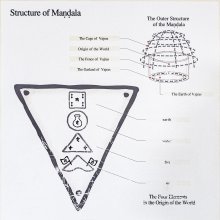Prajvalita: 12 definitions
Introduction:
Prajvalita means something in Buddhism, Pali, Hinduism, Sanskrit, Marathi. If you want to know the exact meaning, history, etymology or English translation of this term then check out the descriptions on this page. Add your comment or reference to a book if you want to contribute to this summary article.
Images (photo gallery)
In Buddhism
Mahayana (major branch of Buddhism)
Source: De Gruyter: A Buddhist Ritual Manual on AgriculturePrajvalita (प्रज्वलित) refers to the “shining forth (of rays)”, according to the Vajratuṇḍasamayakalparāja, an ancient Buddhist ritual manual on agriculture from the 5th-century (or earlier), containing various instructions for the Sangha to provide agriculture-related services to laypeople including rain-making, weather control and crop protection.—Accordingly, [after hostile Nāgas released winds, thunderbolts, etc.] “Then the Bhagavān entered the concentration called the Expanded Garuḍa Glance, [also] called the Miracle of the Garland of Enveloping Flame. Immediately after he had entered the concentration, two rays shone forth. Merely upon shining forth (saha-prajvalita-mātra), the bodies of all Nāgas flamed up”.

Mahayana (महायान, mahāyāna) is a major branch of Buddhism focusing on the path of a Bodhisattva (spiritual aspirants/ enlightened beings). Extant literature is vast and primarely composed in the Sanskrit language. There are many sūtras of which some of the earliest are the various Prajñāpāramitā sūtras.
Languages of India and abroad
Marathi-English dictionary
Source: DDSA: The Molesworth Marathi and English Dictionaryprajvalita (प्रज्वलित).—p S Kindled or inflamed, lit. fig.
Source: DDSA: The Aryabhusan school dictionary, Marathi-Englishprajvalita (प्रज्वलित).—p Kindled or inflamed.
Marathi is an Indo-European language having over 70 million native speakers people in (predominantly) Maharashtra India. Marathi, like many other Indo-Aryan languages, evolved from early forms of Prakrit, which itself is a subset of Sanskrit, one of the most ancient languages of the world.
Sanskrit dictionary
Source: DDSA: The practical Sanskrit-English dictionaryPrajvalita (प्रज्वलित).—p. p.
1) Being in flames, burning, flaming, blazing.
2) Bright, shining.
3) Burnt.
-tam Burning.
Source: Cologne Digital Sanskrit Dictionaries: Shabda-Sagara Sanskrit-English DictionaryPrajvalita (प्रज्वलित).—mfn.
(-taḥ-tā-taṃ) 1. Blazing, radiant. 2. Burnt. E. pra implying excess, jvalita burning.
--- OR ---
Prajvālita (प्रज्वालित).—mfn.
(-taḥ-tā-taṃ) Lighted, kindled. E. pra before, jval to blaze, causal v., kta aff.
Source: Cologne Digital Sanskrit Dictionaries: Cappeller Sanskrit-English DictionaryPrajvalita (प्रज्वलित).—[neuter] the same.
Source: Cologne Digital Sanskrit Dictionaries: Monier-Williams Sanskrit-English Dictionary1) Prajvalita (प्रज्वलित):—[=pra-jvalita] [from pra-jval] mfn. flaming, blazing, burning, shining, [Lāṭyāyana; Mahābhārata; Kāvya literature] etc.
2) [v.s. ...] n. flaming up, blazing, burning, [Harivaṃśa]
3) Prajvālita (प्रज्वालित):—[=pra-jvālita] [from pra-jval] mfn. lighted, kindled, [Monier-Williams’ Sanskrit-English Dictionary]
Source: Cologne Digital Sanskrit Dictionaries: Yates Sanskrit-English Dictionary1) Prajvalita (प्रज्वलित):—[pra-jvalita] (taḥ-tā-taṃ) a Blazing, burnt.
2) Prajvālita (प्रज्वालित):—[pra-jvālita] (taḥ-tā-taṃ) p. Lighted.
Source: DDSA: Paia-sadda-mahannavo; a comprehensive Prakrit Hindi dictionary (S)Prajvalita (प्रज्वलित) in the Sanskrit language is related to the Prakrit words: Paulia, Pajjalia, Pajjaliya, Pajjālia.
[Sanskrit to German]
Sanskrit, also spelled संस्कृतम् (saṃskṛtam), is an ancient language of India commonly seen as the grandmother of the Indo-European language family (even English!). Closely allied with Prakrit and Pali, Sanskrit is more exhaustive in both grammar and terms and has the most extensive collection of literature in the world, greatly surpassing its sister-languages Greek and Latin.
Kannada-English dictionary
Source: Alar: Kannada-English corpusPrajvalita (ಪ್ರಜ್ವಲಿತ):—[adjective] = ಪ್ರಜ್ವಲ [prajvala]1.
--- OR ---
Prajvalita (ಪ್ರಜ್ವಲಿತ):—[noun] = ಪ್ರಜ್ವಲನ [prajvalana].
--- OR ---
Prajvaḷita (ಪ್ರಜ್ವಳಿತ):—[adjective] = ಪ್ರಜ್ವಲ [prajvala]1.
--- OR ---
Prajvaḷita (ಪ್ರಜ್ವಳಿತ):—[noun] = ಪ್ರಜ್ವಲನ [prajvalana].
Kannada is a Dravidian language (as opposed to the Indo-European language family) mainly spoken in the southwestern region of India.
See also (Relevant definitions)
Partial matches: Pra, Jvalita.
Ends with: Aprajvalita, Dushprajvalita, Samprajvalita, Svayamprajvalita.
Full-text: Pajjalia, Paulia, Jamadagni, Svayamprajvalita, Pajjaliya, Samprajvalita, Paulla, Sajyotibhuta, Jval, Adinava, Pata.
Relevant text
Search found 5 books and stories containing Prajvalita, Pra-jvalita, Pra-jvālita, Prajvālita, Prajvaḷita; (plurals include: Prajvalitas, jvalitas, jvālitas, Prajvālitas, Prajvaḷitas). You can also click to the full overview containing English textual excerpts. Below are direct links for the most relevant articles:
Padarthadharmasamgraha and Nyayakandali (by Ganganatha Jha)
Text 127 < [Chapter 6a - On Qualities]
Maha Prajnaparamita Sastra (by Gelongma Karma Migme Chödrön)
Part 2 - The benefits of exertion < [Chapter XXVI - Exertion]
The Garuda Purana (by Manmatha Nath Dutt)
Chapter CCVII - Various other medicinal Recipes (continued) < [Dhanvantari Samhita]
The Devi Bhagavata Purana (by Swami Vijñanananda)
Atharvaveda and Charaka Samhita (by Laxmi Maji)
1b. Study of Fever (Jvara) in the Caraka-Saṃhita < [Chapter 5 - Diseases and Remedies in Atharvaveda and Caraka-Saṃhitā]
